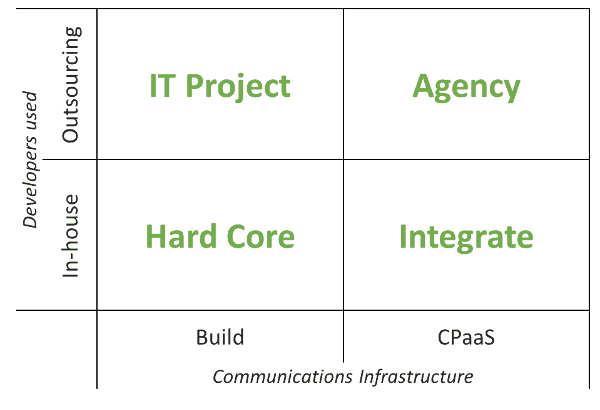There’s an underlying theme to questions from those approaching me. They most often than not consider what to pick as their WebRTC development path.

Before we continue – there’s a huge discount on my WebRTC PaaS report this month – so make sure you don’t miss it.
–
About 10 years ago or so, a large LCD manufacturer came to the company I worked for. They wanted to build a monitor that has an embedded video conferencing endpoint in it. It was revolutionary at the time. Beautiful. Aggressive. And we won the project. That was when the hard work started – we had to pick out a team to build it.
We had some of the best VoIP developers out there at the time. Our business unit licensed the technology to everyone and anyone who did anything with VoIP, so it made sense to self develop. And yet… we found ourselves hiring around 8 more developers for this project. All with skillsets different than the ones we already had. We were missing in the domain of media processing, codecs and hardware.
In almost any case, when it comes to WebRTC, the skillset you already have in place will not be exactly what is necessary to get the job done.
You will either have to hire the skillset, teach your current workforce new tricks or outright outsource the work.
Which means that when you start thinking about a product that needs real time communications, there are usually 2 routes you can pick when it comes to the WebRTC development part:
- Use in-house developers
- Use an outsourcing vendor
And in them, there are 2 additional aspects to decide upon:
- Develop and maintain your own infrastructure
- Use a 3rd party CPaaS
This all leads to the following WebRTC development matrix:

There are 4 classic development paths that I see companies take with their projects.
#1 – Hard Core
The Hard Core development model is all about control and core competencies.
At the extreme, these vendors will tend to “live off the land” and go as far as building their own SFU from scraps of code they cobble up around the web.
What they see as imperative in front of them is to be the best at communications – and to rely as little as possible on others.
For the most part, these would be companies with existing VoIP heritage who make the plunge towards a WebRTC project. At times though, they can be brand new to VoIP and for them, it starts as an adventure of sorts.
Another vendor type in this space would be the NIH type of a vendor. Where the Not Invented Here synrome is high, and trust on others to deliver what is needed is non-existent. These guys know better than everyone else how to put this type of an infrastructure in place and no explanation would deter them. Their best argument? CPaaS is too darn expensive when you start counting the minutes. And I already said – WebRTC is… free.
If you need to train your developers for WebRTC, then check out my WebRTC codelab training.
#2 – IT Project
The IT Project development model is about ownership.
The end game here, is to own the infrastructure and the data flow. Companies will tend to go to this approach if they have a regulatory issue they need to deal with (such as “data can’t travel out of the country”), a need to serve a specific geography (China for example) or special requirements that translates into the need of using their own infrastructure since others won’t support it (real time video analytics in the backend comes to mind).
As with the Hard Core players, they will be those who simply fancy the idea of ownership.
Why is this an IT Project then? Because an external outsourcing vendor is taken to develop it for the company. Usually because the internal workforce doesn’t have the experience, overbooked, or just more expensive.
#3 – Integrate
The Integrate develoment model is about getting things done.
You have the developers in place. They are already building your product/app/service/whatever. And you direct them to a CPaaS vendor of your choosing to work on top.
Why? Because communications isn’t your core business. Because it is cheaper. Because it gives you faster time to market. Have a pick of your reason for it – there are quite a few.
#4 – Agency
The Agency development model is about the dream.
You have a dream. You want to get it done. But you don’t really have the experience or the manpower. But you have some budget for it. What do you do?
Find and outsourcing vendor to build the product for you. Use CPaaS to work on top, so ongoing maintainance will be kept at a minimum if possible. And have that delivered to you.
Simple. If you pick the right outsourcing vendor. And the right CPaaS vendor. And the stars align just the right way to give you the luck needed in any development project.
How to choose your path?
I am in the process of updating and beefing up my WebRTC PaaS report, which is geared towards the vendor selection process of a CPaaS vendor. This time, I’ll be enhancing it to cover the IT Project, Agency and CPaaS quadrants.
Until I do, I am lowering down the price of the currently available WebRTC PaaS report from $1,950 down to $199. This should make it affordable to anyone who is planning on investing any kind of time or money in this space.
There are a few caveats:
- This discount is available ONLY during February. The price will rise in March when the updated report is ready
- The report will not include any of the extras – just the report itself
- Specifically, it won’t come with any 1-year updates
Those who purchase the report now will be given a discount later on if they wish to go for the 1-year update package. Which means there’s nothing for you to lose when grabbing the report now at a huge discount.
